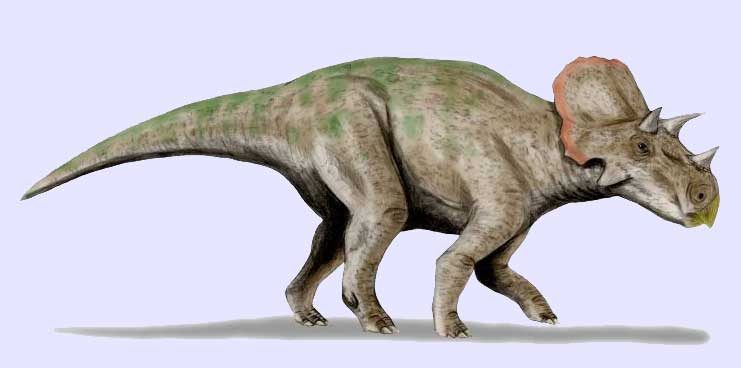Avaceratops lammersi. (*)
Avaceratops is a genus of small ceratopsian dinosaur which lived during the late Campanian during the Late Cretaceous Period in what is now the Northwest United States. Discoveries and species The first fossils of Avaceratops were found in the Judith River Formation of Montana, in 1981.[1] They were preserved scattered through-out the remains of a prehistoric stream bed.[1] This Avaceratops specimen was likely buried in the sandbar after its body was swept downstream by the current.[1] The original find was made by Eddie Cole and the fossils were formally named in 1986, by Peter Dodson. It was named after Ava, Eddie's wife.[1] The species epithet honors the Lammers family, who owned the land where the holotype fossil was found.[1] Classification Avaceratops belonged to the family Ceratopsidae within the Ceratopsia (both names being derived from Ancient Greek for 'horned face'), a group of herbivorous dinosaurs with parrot-like beaks which thrived in what are now North America and Asia, during the Cretaceous Period. Apart from being a ceratopsian, little is certain about Avaceratops's taxonomic position. It is a smallish Ceratopsian with a solid frill[1] (i.e. lacking fenestrae which are typical of many other genera except Triceratops), thus it may be somehow ancestral to Triceratops or occupy a position between the two subfamilies Centrosaurinae and Ceratopsinae. This latter opinion was the one reached by Penkalski and Dodson in 1999. Diet Avaceratops, like all ceratopsians, was a herbivore. During the Cretaceous, flowering plants were "geographically limited on the landscape", so it is likely that this dinosaur fed on the predominant plants of the era: ferns, cycads and conifers. It would have used its sharp ceratopsian beak to bite off the leaves or needles. References * Dodson, P. (1996). The Horned Dinosaurs. Princeton University Press, Princeton, New Jersey. ISBN 0-691-05900-4. 1. ^ a b c d e f "Avaceratops." In: Dodson, Peter & Britt, Brooks & Carpenter, Kenneth & Forster, Catherine A. & Gillette, David D. & Norell, Mark A. & Olshevsky, George & Parrish, J. Michael & Weishampel, David B. The Age of Dinosaurs. Publications International, LTD. p. 129. ISBN 0-7853-0443-6.
Retrieved from "http://en.wikipedia.org/" |
|

